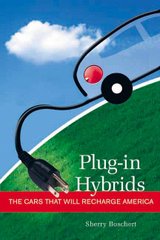Greater support for mass transit and appropriate land use policies that make mass transit accessible are essential. They are essential for more livable communities and more efficient use of resources, including energy. However, we have created a nation that is dependent, for the foreseeable future, upon the automobile. And many of the rest of the world’s inhabitants aspire to automobile ownership. China has opened up high-speed rail lines while the United States fiddles. Yet simultaneously, China has overtaken the United States in the number of automobiles sold annually.
 City of San FranciscoSan Francisco recently became the first city in the country to mandate plug-in charging stations
City of San FranciscoSan Francisco recently became the first city in the country to mandate plug-in charging stations
for all new buildings.
Despite billions of dollars of investment, in most of the United States only a tiny percentage of people use mass transit regularly. The latest report by the American Public Transportation Association documents a 3.8 percent decline in ridership overall in the first nine months of 2009. Designing our cities and regions around mass transit is something we must do, but it is a multi-generational project.
In other developed countries – in Europe and Asia, for example – clean, electric public transit is the principal means of transportation. In most of the developing world, public transit remains the only viable means of getting around. But the commuters in poorer nations usually travel in a haze of pollution created by petroleum-powered trains and buses. The basic problem that faces transportation today isn’t whether people travel on mass transit or in automobiles, but rather the technology and fuel employed.
The question that faces us is how to ensure that our mass transit and private cars minimize the negative environmental impacts of travel. To do that we must set our nation, and the world, on a path to eliminate petroleum as the predominant fuel for transportation. To continue to rely on petroleum is to accept as inevitable the immense political power of the world’s wealthiest corporations and the resultant pollution, climate change, and war. There is no catalytic converter that can fully scrub the toxics that result from burning oil. And there is no way to democratize the production and distribution of petroleum.
There is, however, an alternative path: Electricity. It’s been around a long time and powers just about everything we use except transportation. It’s ubiquitous, relatively price stable due to government regulation, and is created in many ways, increasingly including renewable – such as solar, wind and geothermal – sources.
Of course we need energy to create electricity, and just as we’ve been burning petroleum for a century to move us and our stuff around, we’ve been burning oil and coal and natural gas to create electricity. While burning all those fuels has caused pollution just as surely as gasoline cars and trucks, we have options. As aging, filthy coal power stations are retired, they are often replaced with cleaner-burning natural gas generators. And now we are making a commitment to renewable electricity generation. Multiple sources of electricity generation make the grid reliable. In contrast, there is no effort to protect our transportation “grid” from vulnerabilities to petroleum’s monopoly.
While our electricity generation is becoming cleaner and more renewable due to state and federal mandates, switching to electricity for transportation immediately lowers emissions. On the existing US electric grid, half of which is powered by dirty coal, an electric car already is less polluting and emits fewer greenhouse gases than the average gasoline car. In the worst cases, like some nearly 100 percent-coal-powered states, the emissions profiles may be a wash. In others, like California and Texas, which use a preponderance of natural gas, it’s truly a slam dunk for electric transportation. Given our commitment to ever more solar, wind, and other renewables, electric transportation will only get cleaner.
Only with an electric car could you aspire not only to zero-emission driving, but to making your own zero-emission electricity to feed it. Putting solar PV panels on one’s roof is not rocket science, nor out of reach for millions of homeowners. With renewable power and plug-in cars, we can begin to get control over our energy destiny.
A central goal of the twenty-first century must be to bring the revolution of electrification to transportation – and that will include both mass transit and personal vehicles.


